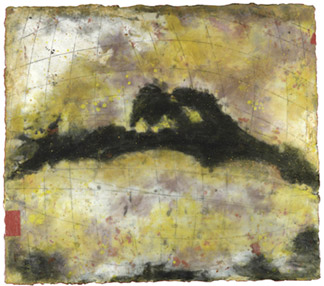
In "Solar Flare," painter Elise Wagner played variations on the theme of the music of the spheres. In semi-abstract oil and encaustic paintings and monoprints, the artist married gesture, order, and romance, subdividing picture planes into star-chart grids atop which she superimposed imagery suggestive of celestial bodies, in particular the sun. Nowhere did this technique work more effectively than in the searing Solar Flare Study, its broad, gestural arc of oxblood-colored fire shimmering in an outline of gold. While suggesting the subject matter of its title, its splatters and drips imparted an action-painting kineticism that functioned quite independently of any referent. The similarly composed Corona Flare danced across the horizontal panel with similar elan but a more representational technique.
Throughout the series, Wagner utilized a vocabulary of ancient symbols drawn from runestones, alchemy texts, and other historic sources, embedding them within the encaustic medium. The symbols lent an arcane, sometimes sinister effect, as in Sun Storm Table, whose dark, nebular form oozed across the composition with a sense of menace. The waxy surfaces allowed the artist to impart nubby textural effects, such as the pockmark-like indentations in her Solar Riddle series. These works exploited the medium's topographic properties and opacity, suggesting the oxidative corrosion of antique books or maps. Occasionally the medium was not as aptly deployed. Pieces such as Funnel Cloud and a series of works painted on shingles lacked sheen, turning the eye away rather than inviting it into the paintings.
With the exception of the amorphous Vapor Scape, the works were compositionally strong. Some employed framing devices such as the curvilinear incursions and scalloped edges of Solar Flare I, which had the look of an oversized scroll of gold-and-blue parchment paper. Riddle Cloud took a similar tack in a palette of cerulean and ecru. Between the cartographic gridding, antiquarian touches, and embedded symbology, the show took a mystical look back at, rather than a futuristic look ahead toward, the vault of heaven. In Wagner's vision, the night skies were not so much the subject of astronomical quantification as the stuff of astrological wonderment, harkening to an age when terra incognita remained above the earth and under the sun.
This article was written for and published in art ltd. magazine ![]()
